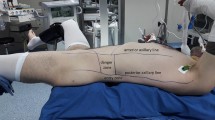Abstract
Aim
The aim of this study was to determine the factors facilitating the supine percutaneous nephrolithotomy technique in learning curve, to compare the supine and prone technique results. Material and methods: 47 patients who required percutaneous nephrolithotomy were included in this study, and they were divided into two groups as supine and prone. Prone technique was performed to 24 patients in the first group. In the second group, the supine technique was performed by calculating the patient-specific access angle for 23 patients. Demographic, preoperative, intraoperative, postoperative parameters, transfusion, and complications of both groups were compared. Results: Age, gender, side, stone size, stone-free rate, and length of stay in hospital were not statistically significant between the groups. Operation and fluoroscopy time were lower in the supine group, but it was not statistically significant. The decrease in hemoglobin was higher in the supine group and it was statistically significant (p = 0.027). The decrease in hemoglobin was not symptomatic in both groups. In addition, transfusion rates were similar and not statistically significant. Discussion: In previous studies, the supine technique was evaluated in terms of many factors. Process steps were tried to be standardized and improvements were made in the access technique. The supine technique, which uses patient-specific access angle, has similar complication rates as the prone technique. However, the operation and fluoroscopy times are shorter than the prone technique. For surgeons on the learning curve, the supine technique is safe, feasible, and has even shorter operating times with a patient-specific access angle.




Similar content being viewed by others
Data availability
We declare that the database generated during and/or analysed during the current study are available from the corresponding author on reasonable request.
References
Eryildirim B, Kucuk EV, Atis G et al (2018) Safety and efficacy of PNL vs RIRS in the management of stones located in horseshoe kidneys: a critical comparative evaluation. Arch Ital Urol Androl 90(3):149–154. https://doi.org/10.4081/aiua.2018.3.149
Ucer O, Erbatu O, Albaz AC et al (2022) Comparison stone-free rate and effects on quality of life of percutaneous nephrolithotomy and retrograde intrarenal surgery for treatment of renal pelvis stone (2–4 cm): a prospective controlled study. Curr Urol 16(1):5–8. https://doi.org/10.1097/CU9.0000000000000071
Valdivia Uría JG, Valle Gerhold J, López López JA et al (1998) Technique and complications of percutaneous nephroscopy: experience with 557 patients in the supine position. J Urol 160(6 Pt 1):1975–1978. https://doi.org/10.1016/s0022-5347(01)62217-1
Falahatkar S, Moghaddam AA, Salehi M et al (2008) Complete supine percutaneous nephrolithotripsy comparison with the prone standard technique. J Endourol 22(11):2513–2517. https://doi.org/10.1089/end.2008.0463
Keller EX, Coninck DE, V, Proietti S, et al (2021) Prone versus supine percutaneous nephrolithotomy: a systematic review and meta-analysis of current literature. Minerva Urol Nephrol 73(1):50–58. https://doi.org/10.23736/S2724-6051.20.03960-0
Falahatkar S, Mokhtari G, Teimoori M (2016) An update on supine versus prone percutaneous nephrolithotomy: a meta-analysis. Urol J 13(5):2814–2822. https://doi.org/10.22037/uj.v13i5.3677
Bach C, Goyal A, Kumar P et al (2012) The Barts “flank-free” modified supine position for percutaneous nephrolithotomy. Urol Int 89(3):365–368. https://doi.org/10.1159/000341430
Basiri A, Mohammadi Sichani M (2009) Supine percutaneous nephrolithotomy, is it really effective? A systematic review of literature. Urol J 6:73–77
Hoznek A, Rode J, Ouzaid I et al (2011) Modified supine percutaneous nephrolithotomy for large kidney and ureteral stones: technique and results. Eur Urol 61(1):164–170. https://doi.org/10.1016/j.eururo.2011.04.031
Curry D, Srinivasan R, Kucheria R et al (2017) Supine percutaneous nephrolithotomy in the galdako-modified valdivia position: a high-volume single center experience. J Endourol 31(10):1001–1006. https://doi.org/10.1089/end.2017.0064
Wu P, Wang L, Wang K (2011) Supine versus prone position in percutaneous nephrolithotomy for kidney calculi: a meta-analysis. Int Urol Nephrol 43:67–77. https://doi.org/10.1007/s11255-010-9801-0
Liu L, Zheng S, Xu Y, Wei Q (2010) Systematic review and meta-analysis of percutaneous nephrolithotomy for patients in the supine versus prone position. J Endourol 24(12):1941–1946. https://doi.org/10.1089/end.2010.0292
Tzou DT, Metzler IS, Usawachintachit M, Stoller ML, Chi T (2019) Ultrasound-guided access and dilation for percutaneous nephrolithotomy in the supine position: a step-by-step approach. Urology 133:245–246. https://doi.org/10.1016/j.urology.2019.07.022
Yazici CM, Kayhan A, Dogan C (2014) Supine or prone percutaneous nephrolithotomy: do anatomical changes make it worse? J Endourol 28(1):10–16. https://doi.org/10.1089/end.2013.0541
Jang WS, Choi KH, Yang SC et al (2011) The learning curve for flank percutaneous nephrolithotomy for kidney calculi: a single surgeon’s experience. Korean J Urol 52(4):284–288. https://doi.org/10.4111/kju.2011.52.4.284
Li J, Gao L, Li Q, Zhang Y, Jiang Q (2019) Supine versus prone position for percutaneous nephrolithotripsy: a meta-analysis of randomized controlled trials. Int J Surg 66:62–71. https://doi.org/10.1016/j.ijsu.2019.04.016
Funding
None.
Author information
Authors and Affiliations
Contributions
All surgical interventions were performed by the primary author, Alper Nesip Manav. All the authors contributed equally to the study design, data acquisition, data analysis, drafting of manuscript, and critical revision of the manuscript. All the authors read and approved the final manuscript.
Corresponding authors
Ethics declarations
Conflict of interest
The authors declare that they have no conflicts of interest.
Ethical approval
All procedures performed in human studies were approved by the Human Research Ethics Committee of the Adnan Menderes University (Committee’s reference number: 2021/121) and were performed in accordance with the ethical standards of the 1964 Helsinki Declaration and its later amendments.
Informed consent
Informed consent was obtained from all individual participants included in this study.
Additional information
Publisher's Note
Springer Nature remains neutral with regard to jurisdictional claims in published maps and institutional affiliations.
Rights and permissions
Springer Nature or its licensor (e.g. a society or other partner) holds exclusive rights to this article under a publishing agreement with the author(s) or other rightsholder(s); author self-archiving of the accepted manuscript version of this article is solely governed by the terms of such publishing agreement and applicable law.
About this article
Cite this article
Manav, A.N., Güzel, A. Is supine position safe and effective for the percutaneous nephrolithotomy? Clinical experiences, tip and tricks in learning curve and PSAA technique. Urolithiasis 51, 62 (2023). https://doi.org/10.1007/s00240-023-01431-9
Received:
Accepted:
Published:
DOI: https://doi.org/10.1007/s00240-023-01431-9



